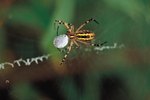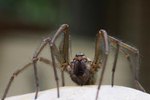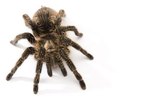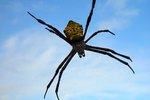If you've encountered a tiny black spider that jumps, it's probably a jumping spider. Few other spiders jump, and hardly any others jump as adults. Jumping spiders are commonly found in houses, so running into one of these eight-legged acrobats is pretty easy.
An Energetic Family
Family Salticidae is the jumping spiders -- after "salta," meaning "jump." These robust little balls of energy are some of the smallest spiders, but perform some of the greatest physical feats of any arachnid. They have excellent eyesight, large and well-developed brains, and don't build webs. Instead, they actively hunt by sight in daylight. When they encounter a tasty insect, they run and leap, sometimes jumping more than a hundred times their own body length. Most can jump and land from vertical as well as horizontal surfaces, and it's easy to find them hunting inside and out, such as on windowsills, walls and tree trunks.
Dark and Mysterious Gentlemen
Jumping spiders top the charts in terms of numbers, at more than 5,000 known species spread across every continent except Antarctica. Many are dark gray or black, at least in part, for at least part of their lives. They're often quite striking, usually accented with bright blotches of red, green, or iridescent blue, or with white stripes -- but their color usually changes several times between hatching and reaching adulthood, so it can be nearly impossible to tell which species you've met. To further complicate matters, single species can have multiple color and pattern morphs, and males usually look different than females.
Wolves on the Prowl
The other potential suspect is a juvenile wolf spider. Wolf spiders are members of family Lycosidae, with more than 2,000 species, many dark gray or black. Like jumping spiders, they're terrestrial hunters who don't build webs. Unlike them, wolf spiders have poor eyesight and don't usually chase their prey very far or perform acrobatic leaps. They wait until prey wanders near, then pounce. Their moms care for them for several weeks after hatching. They start hunting on their own when they're about 1/8 of an inch long. It's common to meet lots and lots of them in fields several weeks after hatching season. The young, poorly sighted, inexperienced spiders are likely to jump on anything that moves in the hope of catching dinner.
Risky Business vs. Treasured Pals
All this jumping may seem intimidating, but rest assured neither type poses any harm to you. Contrary to popular belief, only five types of North American spiders are capable of biting humans, and jumping spiders aren't on the list. They're much too small and can't break your skin. Some adult wolf spiders can bite, but do so only in self-defense and their venom isn't poisonous to humans. Juveniles can't bite -- their fangs are too small to pierce your skin. All spiders, however, eat many times their weight in pest insects, including common household nuisances such as flies and cockroaches.
References
- Reptilia.net: Wolves With Eight Legs - An Introduction to the Wolf Spiders
- University of Kentucky Entomology: Wolf Spiders
- Jumping Spiders Worldwide Database: Jumping Spiders (Arachnida: Aranaea: Salticidae) of the World
- Pennsylvania State University Entomology: Spider - The Bold Jumper
- University of Minnesota Extension: Common Spiders In and Around Homes
- BugGuide.net: Guide to Common Jumping Spiders
Resources
Writer Bio
Angela Libal began writing professionally in 2005. She has published several books, specializing in zoology and animal husbandry. Libal holds a degree in behavioral science: animal science from Moorpark College, a Bachelor of Arts from Sarah Lawrence College and is a graduate student in cryptozoology.





